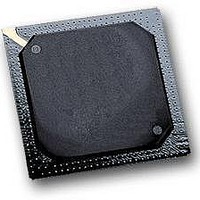MPC564CVR40 Freescale Semiconductor, MPC564CVR40 Datasheet - Page 130

MPC564CVR40
Manufacturer Part Number
MPC564CVR40
Description
IC MPU 32BIT W/CODE COMP 388PBGA
Manufacturer
Freescale Semiconductor
Series
MPC5xxr
Specifications of MPC564CVR40
Core Processor
PowerPC
Core Size
32-Bit
Speed
40MHz
Connectivity
CAN, EBI/EMI, SCI, SPI, UART/USART
Peripherals
POR, PWM, WDT
Number Of I /o
56
Program Memory Size
512KB (512K x 8)
Program Memory Type
FLASH
Ram Size
32K x 8
Voltage - Supply (vcc/vdd)
2.5 V ~ 2.7 V
Data Converters
A/D 32x10b
Oscillator Type
External
Operating Temperature
-40°C ~ 85°C
Package / Case
388-BGA
Processor Series
MPC5xx
Core
PowerPC
Data Bus Width
32 bit
Data Ram Size
32 KB
Interface Type
CAN, JTAG, QSPI, SCI, SPI, UART
Maximum Clock Frequency
40 MHz
Number Of Programmable I/os
56
Number Of Timers
2
Maximum Operating Temperature
+ 85 C
Mounting Style
SMD/SMT
Minimum Operating Temperature
- 40 C
On-chip Adc
2 (10 bit, 32 Channel)
For Use With
MPC564EVB - KIT EVAL FOR MPC561/562/563/564
Lead Free Status / RoHS Status
Lead free / RoHS Compliant
Eeprom Size
-
Lead Free Status / Rohs Status
Details
Available stocks
Company
Part Number
Manufacturer
Quantity
Price
Company:
Part Number:
MPC564CVR40
Manufacturer:
Freescale Semiconductor
Quantity:
10 000
- Current page: 130 of 1420
- Download datasheet (11Mb)
Signal Descriptions
HRESET. However, the signals must not cause any spurious conditions or consume an excessive amount
of power during reset. To prevent these conditions, the signals need to have a defined reset state.
Table 2-14
All signals are initialized to a “reset state” during reset. This state remains active until reset is negated or
until software disables the pull-up or pull-down device based on the signal functionality. Upon assertion
of the corresponding bits in the signal control registers and negation of reset, the signal acquires the
functionality that was programmed.
2.6.3
Power-on reset and hard reset affect the functionality of the signals out of reset. (During soft reset, the
functionality of the signals is unaltered.)
Upon assertion of the power-on reset signal (PORESET/TRST) the functionality of the signal is not yet
known to the RCPU. The weak pull-up or weak pull-down resistors are enabled. The reset configuration
word configures the system, and towards the end of reset the signal functionality is known. Based upon
the signal functionality, the pull-up or pull-down devices are either disabled immediately at the negation
of reset or remain enabled, as shown in
Because hard reset can occur when a bus cycle is pending, the PDMCR bits that enable and disable the
pull-up or pull-down resistors are set or reset synchronously to eliminate contention on the signals.
(PORESET/TRST affects these bits asynchronously.)
2.6.4
2.6.4.1
The pull resistors are enabled and disabled by the corresponding bits in the PDMCR register in the USIU
(see
1), the devices are disabled.
2.6.4.2
The 5-V/2.6-V multiplexed pad does not have a pull-up device. The pull-down will be controlled by the
corresponding bits in the PDMCR register. When this bit is negated, the pull-down is enabled, when
asserted the pull-down will be disabled.
2.6.4.3
For the signals that support debug, opcode tracking, and bus control functionality, the pull resistors will be
controlled by the SPRDS bit in the PDMCR register. During reset this signal will be synchronously used
2-32
Table
2-14). When those bits are negated (logic 0), the pull resistors are enabled. When asserted (logic
describes the reset state of the signals based on signal functionality.
Power-On Reset and Hard Reset
Pull-Up/Pull-Down
Pull-Up/Pull-Down Enable and Disable for 5-V Only and 2.6-V Only
Signals
Pull-Down Enable and Disable for 5-V/2.6-V Multiplexed Signals
Special Pull Resistor Disable Control Functionality (SPRDS)
All pull-up/pull-down devices are disabled when all the signals are forced
to three state in JTAG mode.
MPC561/MPC563 Reference Manual, Rev. 1.2
Table
2-14.
NOTE
Freescale Semiconductor
Related parts for MPC564CVR40
Image
Part Number
Description
Manufacturer
Datasheet
Request
R

Part Number:
Description:
MPC5 1K0 5%
Manufacturer:
TE Connectivity
Datasheet:

Part Number:
Description:
MPC5 500R 5%
Manufacturer:
TE Connectivity
Datasheet:

Part Number:
Description:
MPC5 5K0 5%
Manufacturer:
Tyco Electronics
Datasheet:

Part Number:
Description:
MPC5 5R0 5%
Manufacturer:
Tyco Electronics
Datasheet:

Part Number:
Description:
MPC5 50K 5%
Manufacturer:
Tyco Electronics
Datasheet:

Part Number:
Description:
MPC5 1R0 5%
Manufacturer:
Tyco Electronics
Datasheet:
Part Number:
Description:
Manufacturer:
Freescale Semiconductor, Inc
Datasheet:
Part Number:
Description:
Manufacturer:
Freescale Semiconductor, Inc
Datasheet:
Part Number:
Description:
Manufacturer:
Freescale Semiconductor, Inc
Datasheet:
Part Number:
Description:
Manufacturer:
Freescale Semiconductor, Inc
Datasheet:
Part Number:
Description:
Manufacturer:
Freescale Semiconductor, Inc
Datasheet:












